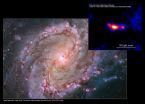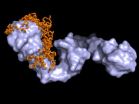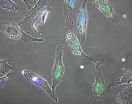(Press-News.org) A team of Australian and American astronomers have been studying nearby galaxy M83 and have found a new superpowered small black hole, named MQ1, the first object of its kind to be studied in this much detail.
Astronomers have found a few compact objects that are as powerful as MQ1, but have not been able to work out the size of the black hole contained within them until now.
The team observed the MQ1 system with multiple telescopes and discovered that it is a standard-sized small black hole, rather than a slightly bigger version that was theorised to account for all its power.
Curtin University senior research fellow Dr Roberto Soria, who is part of the International Centre for Radio Astronomy Research (ICRAR) and led the team investigating MQ1, said it was important to understand how stars were formed, how they evolved and how they died, within a spiral shaped galaxy like M83.
"MQ1 is classed as a microquasar - a black hole surrounded by a bubble of hot gas, which is heated by two jets just outside the black hole, powerfully shooting out energy in opposite directions, acting like cosmic sandblasters pushing out on the surrounding gas," Dr Soria said.
"The significance of the huge jet power measured for MQ1 goes beyond this particular galaxy: it helps astronomers understand and quantify the strong effect that black hole jets have on the surrounding gas, which gets heated and swept away.
"This must have been a significant factor in the early stages of galaxy evolution, 12 billion years ago, because we have evidence that powerful black holes like MQ1, which are rare today, were much more common at the time."
"By studying microquasars such as MQ1, we get a glimpse of how the early universe evolved, how fast quasars grew and how much energy black holes provided to their environment."As a comparison, the most powerful microquasar in our galaxy, known as SS433, is about 10 times less powerful than MQ1.
Although the black hole in MQ1 is only about 100 kilometres wide, the MQ1 structure - as identified by the Hubble Space Telescope - is much bigger than our Solar System, as the jets around it extend about 20 light years from either side of the black hole.
Black holes vary in size and are classed as either stellar mass (less than about 70 times the mass of our Sun) or supermassive (millions of times the mass of our Sun, like the giant black hole that is located in the middle of the Milky Way).
MQ1 is a stellar mass black hole and was likely formed when a star died, collapsing to leave behind a compact mass.
The discovery of MQ1 and its characteristics is just one of the results of the comprehensive study of galaxy M83, a collection of millions of stars located 15 million light years away from Earth.
M83, the iconic Southern-sky galaxy, is being mapped with the Hubble Space and Magellan telescopes (detecting visible light), the Chandra X-ray Observatory (detecting light in X-ray frequencies), the Australia Telescope Compact Array and the Very Large Array (detecting radio waves).
INFORMATION:
ICRAR is a joint venture between Curtin University and The University of Western Australia which receives funding from the State Government of Western Australia.
Original Publication:
'Super-Eddington Mechanical Power of an Accreting Black Hole in M83' published in Science 27/2/2014. Full text available on request.
Contacts
Dr Roberto Soria
ICRAR - Curtin
Ph: +61 8 9266 9665
E: roberto.soria@icrar.org
Kirsten Gottschalk
Media Contact, ICRAR
Ph: +61 8 6488 7771
M: +61 438 361 876
E: kirsten.gottschalk@icrar.org
Monika Dudek
Public Relations Consultant, Curtin University
Ph: +61 8 9266 4241
M: +61 412 266 462
E: media@curtin.edu.au
New fast and furious black hole found
2014-02-28
ELSE PRESS RELEASES FROM THIS DATE:
Researchers discover unusual genetic mutation linked to adolescent liver cancer
2014-02-28
In the race for better treatments and possible cures, rare diseases are often left behind. In a collaboration of researchers at The Rockefeller University, Memorial Sloan Kettering Cancer Center and the New York Genome Center (NYGC), an unusual mutation has been found that is strongly linked to one such disease: a rare liver cancer that affects teens and young adults. The results, published this week in Science, suggest that the mutation plays a key role in the development of the disease, called fibrolamellar hepatocellular carcinoma, and may also underlie more common cancers ...
Retention leads to discipline problems in other kids
2014-02-28
DURHAM, N.C -- When students repeat a grade, it can spell trouble for their classmates, according to a new Duke University-led study of nearly 80,000 middle-schoolers.
In schools with high numbers of grade repeaters , suspensions were more likely to occur across the school community. Discipline problems were also more common among other students, including substance abuse, fighting and classroom disruption.
Public debate typically focuses on how retention affects an individual student's academic performance, said lead author Clara Muschkin. So she and her colleagues ...
Dangerous mistaken identity
2014-02-28
This news release is available in German.
Proteins like the so-called heat shock protein Hsp90 play an important role in almost all processes within human cells. They help other proteins fold into their three-dimensional structure or return damaged proteins back into their proper shape.
Recently, there has been increasing evidence indicating that the heat shock protein HSP90 may also be involved in the folding processes of the tau protein. Deposits of tau proteins in brain cells are typical for Alzheimer's disease and are held responsible for decaying nerve ...
Diabetes and obesity more common in socioeconomically deprived regions
2014-02-28
Living in a socioeconomically deprived region is a risk factor for being affected by diabetes mellitus and obesity. This holds true regardless of the individual social status of the inhabitants. This is the conclusion reached by scientists from the Institute of Health Economics and Health Care Management (IGM) at the Helmholtz Zentrum München (HMGU) and the Department of Epidemiology and Health Monitoring at the Robert Koch Institute (RKI) in Berlin. "Regional factors, such as the population's average income, unemployment or quality of the living environment can affect ...
Unearthing key function of plant hormone
2014-02-28
This news release is available in German.
Plants, like animals, employ hormones as messengers, which coordinate growth and regulate how they react to the environment. One of these plant hormones, auxin, regulates nearly all aspects of plant behavior and development, for example phototropism, root growth and fruit growth. Depending on the context, auxin elicits a range of responses such as cell polarization or division. In this week's edition of Science (DOI:10.1126/science.1245125), a team of researchers including Jiri Friml from IST Austria and led by Zhenbiao ...
Scientists discover the specific types of macrophages that affect Crohn's disease severity
2014-02-28
For those coping with Crohn's disease, a new research report published in the Journal of Leukocyte Biology offers hope for the development of new and more effective drugs. In the report, scientists show for the first time, precisely what type of immune cells are involved in driving the inflammation process in the disease. With this knowledge, new compounds can be identified which reduce the activity of these cells or lessen their inflammatory effects.
"By increasing the knowledge on the different macrophage subsets in the intestine and their blood counterparts, we hope ...
York physicists pave the way for more energy efficient technology
2014-02-28
An international team of scientists led by physicists from the University of York has paved the way for a new class of magnetic materials and devices with improved performance and power efficiency.
Magnetic materials are currently used to store almost all digital information. However, with information processing and storage now making up a significant fraction of the world's energy consumption, continuing improvements in energy efficiency will require new technologies and materials.
A promising development is all-optical thermally induced magnetic switching (TIMS), which ...
Emergency alert in the cell
2014-02-28
When an organism is exposed to life-threatening conditions, it sounds the alarm and a cellular emergency program, the heat shock response, is initiated. However, the name "heat shock response" is misleading. In the beginning of the 1960s, this form of stress response was first observed. Scientists exposed fruit flies to high temperatures and discovered a complex emergency program designated to save single cells and thus the organism itself. Today researchers know that this program is also triggered by other dangers such as radiation or toxic substances. The terminology, ...
Twitter 'big data' can be used to monitor HIV and drug-related behavior, UCLA study shows
2014-02-28
Real-time social media like Twitter could be used to track HIV incidence and drug-related behaviors with the aim of detecting and potentially preventing outbreaks, a new UCLA-led study shows.
The study, published in the peer-reviewed journal Preventive Medicine, suggests it may be possible to predict sexual risk and drug use behaviors by monitoring tweets, mapping where those messages come from and linking them with data on the geographical distribution of HIV cases. The use of various drugs had been associated in previous studies with HIV sexual risk behaviors and ...
Competition breeds new fish species, study finds
2014-02-28
Competition may play an important role during the evolution of new species, but empirical evidence for this is scarce, despite being implicit in Charles Darwin's work and support from theoretical studies.
Dr Martin Genner from Bristol's School of Biological Sciences and colleagues used population genetics and experimental evidence to demonstrate a role for competition that leads to the differentiation of new species within the highly diverse cichlid fishes of Lake Tanganyika in East Africa.
They found that the cichlid fish Telmatochromis temporalis shows two genetically ...





